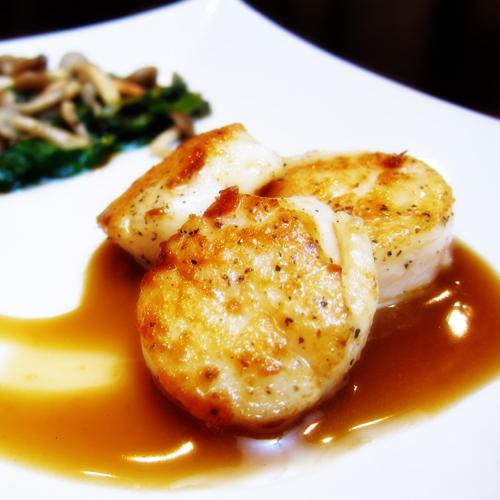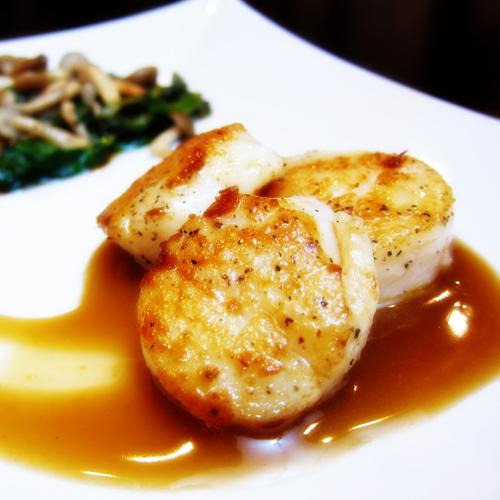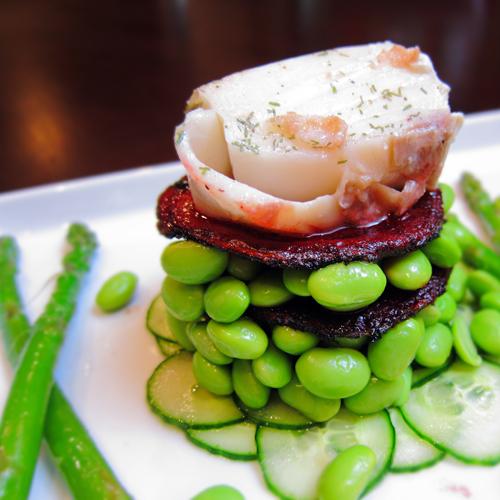-
Posts
7 -
Joined
-
Last visited
Contact Methods
-
Website URL
http://www.siliconvalleysousvide.shutterfly.com
Profile Information
-
Location
Silicon Valley, California
-
Chicken breast is incredible cooked sous vide (145F for 1 hour). It has a transformed texture unlike any other way of cooking chicken breast. Also baby back ribs cooked 155F for 30 hours is "fall of the bones" fantastic. Just season with your favorite BBQ sauce and drop it in. Sear on the grill when done.
-
Hi, Most of the espuma recipes are very similar and use heavy cream as a base with small amount of aeromatics added. You could use say 1 t lemon zest + 1 t lemon juice + 3/4 pint heavy cream. You might also add a little sugar (like 1/2 T). Use a stick blender to blend and then strain. Put into whipper and charge and shake. Should come out light. I made a soy ginger espuma for my scallop dish. The British Larder has a number of espuma recipes http://www.britishlarder.co.uk.
-
As a home sous vide chef, I'm constantly looking for other unique cooking techniques to transform the dining experience at home. I've come across espuma sauces. Espuma is Spanish for "foam" and uses a pressurized canister (cream whipper) using N2O gas to infuse sauces with gas transforming a flat liquid into a foam-like texture. Since sous vide transforms the food texture in many instances (chicken especially for example), I found that adding an espuma sauce to the sous vide meal makes a lot of sense. Anyone else have any comments on this? One thing I haven't found is a good selection of espuma sauces. The British Larder has the most espuma sauces in one place. Anyone have other sources? Cheers, Artie
-
I love my SVS and am glad I got the larger one, however, that said, after doing a fair amount of sous viding for my family (5), I ended up purchasing a Polyscience Professional Chef immersion circulator as well to add to my sous vide arsenal. That's not to say I still don't love my sous vide supreme, I do! Especially the fact that it is dead quiet! The Polyscience uses a powered circulator so it actually humms which is not loud, but constant and above background noise although you do get used to it. If you want to do food for a large party, the sous vide supreme is not large enough. If you pack it too full, it will not be able to hold the temp so you will hear it beep as it loses stability and then regains the temperature (it beeps when it reaches the desired temp). This is annoying so you end up re-arranging or removing bags to allow it to maintain the temperature. The Polyscience can be used in any container. I use it in either a large pot or a large 5 gallon food container which allows me to cook for a large party or cook a full turkey. In actuality, another reason I got the Polyscience in addition to the SVS is that I can not do two types of sous vide cooking in parallel, like vegetable and meat. This is very desirable if you're committed to sous vide on a regular basis.
-
I have done baby back ribs at 155F for 30 hours and they came out incredibly moist and tender. I seared them on an outdoor grill set on high for only a few minutes, brushing them with BBQ sauce. I would classify them as "fall off the bone" tender. From what I understand, for every 10C change you need to double the time. So you could accomplish the same tenderness at 140F for 60-72 hours or increase the temperature to 165F and cook for around 12-15 hours or increase even further to 180F and cut the cooking time to 6-8 hours. They should all achieve roughly the same texture.
-
Stacked Sea Bass, Red Beet Waifs and Edamame on Persian Cucumber base Sous Vide Details: Cook Sea Bass at 135F for 40 minutes Ingredients, Serves 2: 2 Small Sea Bass Steaks (or one cut in half) 2-4 Twigs of fresh dill 1 Large Red beet (should be at least 3 1/2" in diameter) 1 T Unsalted butter 1/4 C Water 1 1/2 C Shelled Edamame (you can get them at an asian market, use regular soybeans if necessary) 1 Persian Cucumber (you can use America or English too) Salt and Pepper Special tool: 3" mold ring This is another variation of the sea food stack. Here we stack sea bass on top of some thin waifs of red beets and layers of edamame soybeans on a base of Persian cucumber coins. Yummie! First, cut your sea bass steaks so that they will fit nicely on top of the stack. You don't want them hanging over the edge! Season them with the dill, salt and pepper on both sides and put them both in a single bag and seal. Pre-heat the water bath to 135F and put the steaks in. Cook for 40-45 minutes. Slice the beets into thin (1/4") slices. Take the largest slices and using your ring mold, cut out 6 perfect circular beet waifs. Melt the better into a sauce pan under medium heat. Put beet slices in, stir to coat and reduce heat to medium-low. Cook on one side for 1 minute and then flip and cook on other side for 1 minute. Add the water and simmer until reduced to a glaze (about 5 minutes). Set aside. Boil a pot of water and blanch the edamame beans for 3-4 minutes. Drain and rinse under cold water. Set aside. Using a mandoline set at the thinnest setting, make cucumber coins. Be very careful not to slice your fingers! Lightly salt the coins. When the steaks are done, remove them from the water bath and bag. To assemble the plate, arrange the cucumber coins on the plate in a circular spiral, overlaying the previous one until you have built a 5" diameter base. Build it as high as you like, but I wouldn't go more than 3-4 high. Put the ring mold in the center and add a beet waif. Add some edamame and then another beet waif. Add another layer of edamame and then a final beet waif. Carefully remove the ring mold and carefully place the sea bass on the top. Present and enjoy!
-

Sous Vide: Recipes, Techniques & Equipment, 2011
siliconvalleysousvide replied to a topic in Cooking
I have a sous vide specific website with a "basics" page that might be helpful (http://www.siliconvalleysousvide.shutterfly.com). It has a basic temperature and time chart, although part of the reason there aren't a lot of "general" temperature and time charts is that you have to be careful about pathogen proliferation which occurs in the 40 to 125F range for meats, poultry and fish. So depending on the thickness of the food you are sous viding, you need to get the core temperature to a level where the pathogens are not proliferating. Since there is a time/temperature relationship in which pathogens are significantly reduced (die), it is hard to just give a temperature at which to cook something at. I hope this makes sense. Cheers Artie




